Supportive laws and policies help protect adolescent and young members of key populations. There are many tools to mobilize and support them in advocating for their rights, for positive change and to fight stigma, discrimination and violence.
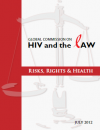 Risks, rights and health: Final report of the Global Commission on HIV and the Law
Risks, rights and health: Final report of the Global Commission on HIV and the LawRecommendations on removing punitive legislation and promoting enabling laws, policies and practices that facilitate inclusive, rights-based, evidence-informed and effective/efficient responses to HIV. The 2018 supplement highlights developments globally in the six years since the publication of the original report, taking into account the context of Agenda 2030 and the Sustainable Development Goals.
HIV and the Law - Risks, rights and health 2012
HIV and the Law - Risks, rights and health SUPPLEMENT 2018
HIV and the Law - Risques, droit et sante
HIV and the Law - Riscos, direitos e saude
HIV and the Law - Риски, права и здоровье
HIV and the Law - Riesgos, direchos y salud
Global Commission on HIV and the Law, 2018
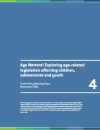 Age Matters! Exploring age-related legislation affecting children, adolescents and youth
Age Matters! Exploring age-related legislation affecting children, adolescents and youthThis working paper explores age-related legal provisions for children, adolescents and youth in 22 countries and across more than 70 domains. It discusses the foundational principles of minimum age legislation, beginning with the principle of non-discrimination, followed by the best interests of the child, the notions of protection and autonomy, and respect for the views of the child and evolving capacities.
UNICEF, 2016
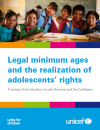 Legal minimum ages and the realization of adolescents’ rights: A review of the situation in Latin America and the Caribbean
Legal minimum ages and the realization of adolescents’ rights: A review of the situation in Latin America and the CaribbeanThe study aims to support the capacity of UNICEF and its partners to advocate for legal minimum ages that guarantee adolescents’ rights, in particular their protection against all forms of violence and their development to their full potential. The analysis concentrates on legislative provisions concerning minimum ages - including for marriage, sexual consent, and medical consent (without parental consent) - and how these play out in the broader context.
UNICEF, 2016
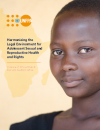 Harmonizing the legal environment for adolescent sexual and reproductive health and rights: A review of 23 countries in East and Southern Africa
Harmonizing the legal environment for adolescent sexual and reproductive health and rights: A review of 23 countries in East and Southern AfricaThis study reviews the laws, policies and related frameworks in 23 countries in East and Southern Africa that create impediments to, or an enabling environment for, adolescent sexual and reproductive health and reproductive rights. It presents a harmonized regional legal framework, translating international and regional legal provisions into useful strategies.
UNFPA, 2017
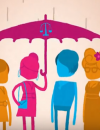 Sex work: The four legal models
Sex work: The four legal models This video explains four legal models for sex work in a short and accessible format, as a resource for advocacy and training.
SWEAT, 2017
 Comparing models of drug decriminalisation: An e-tool
Comparing models of drug decriminalisation: An e-tool Models of decriminalization vary widely. This e-tool makes it possible to compare them side by side, mapping out how they work in practice, describing their legal framework, the role of the police (if any), the judicial or administrative process, the applicable sanction (if any), and examples of countries illustrating each model.
IDPC, EHRN
 Model drug law for West Africa: A tool for policymakers
Model drug law for West Africa: A tool for policymakersThe Model Drug Law contains legislative provisions and commentary incorporating the obligations of the three UN drug control treaties. It also takes into account the outcomes and commitments from the 2016 UNGASS on the world problem, and the ECOWAS Drug Action Plan to Address Illicit Drug Trafficking, Organized Crime and Drug Abuse in West Africa (2016-2020), as well as existing evidence of effectiveness, the need for greater harmonisation of drug laws in the region, and the current gaps in legislation.
Loi type sur les drogues pour l'Afrique de l'Ouest
West African Commission on Drugs, 2018
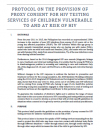 Protocol on the provision of proxy consent for HIV testing services of children vulnerable to and at risk of HIV
Protocol on the provision of proxy consent for HIV testing services of children vulnerable to and at risk of HIV Describes the rationale, legal basis and a detailed management flowchart for authorizing some service-providers to give proxy consent for minors to receive HIV counselling and testing, in the absence of parental consent.
Council for the Welfare of Children, 2018
 Training toolkit on drug policy advocacy
Training toolkit on drug policy advocacy A toolkit for building the capacity of civil society organizations to engage with and influence drug policymaking processes. It covers drug policy, civil society advocacy and harm reduction, with 10 individual modules and accompanying slides that can be downloaded from the website. An adaptation of the toolkit for West Africa, in French, is also available from the IDPC website.
IDPC, EHRN, 2013
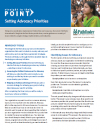 Straight to the point: Tools for behavior change activities and information, education and communication (IEC)
Straight to the point: Tools for behavior change activities and information, education and communication (IEC) These four concise tools explain and provide practical steps for: a) Identifying and prioritizing behavior change needs, b) Assessing partner capacity for behavior change activities, c) Evaluating behavior change activities, and d) evaluating IEC materials. The tools are also available in French and Portuguese on Pathfinder International's website.
Identifying and prioritizing behavior change needs
Assessing partner capacity for behavior change activities
Evaluation of behavior change activities
Evaluation of IEC materials
Pathfinder International, 2011
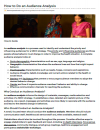 How to do an audience analysis [for social and behaviour change communication]
How to do an audience analysis [for social and behaviour change communication]A brief guide to audience analysis.
HC3, 2013
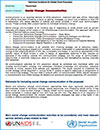 Social change communication: Technical guidance for Global Fund proposals
Social change communication: Technical guidance for Global Fund proposalsThis short document articulates social and behaviour change communications activities that should be included in proposals for funding to the Global Fund.
UNAIDS, WHO
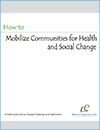 Essential elements of SBCC programs for urban adolescents
Essential elements of SBCC programs for urban adolescents This is the second part of a web-based implementation kit for social and behaviour change (SBCC) campaigns on sexual and reproductive health with urban adolescents. It covers seven elements of SBCC campaigns, with step-by-step guides, resources, and worksheets for creating a campaign. A French version is also available from the same website.
HC3, 2016
 How to develop indicators for SBCC
How to develop indicators for SBCCA short step-by-step guide to defining and creating high-quality indicators for social and behaviour change communication.
HC3
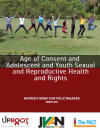 "Uproot" policy briefs on young people and HIV, sexual health and participation
"Uproot" policy briefs on young people and HIV, sexual health and participationA set of six policy briefs produced by young people and aimed at policymakers, with information on the main legal and policy barriers that young people face to access HIV and other sexual and reproductive health services. It explains how harmful laws and policies can affect their health and jeopardize the realization of rights, and lays out recommendations for more enabling policies.
Age of consent and adolescent and youth sexual and reproductive health and rights
Legislative reform and adolescent and youth sexual and reproductive rights
Spousal consent to HIV services and sexual and reproductive health services and rights
Comprehensive sexuality education and sexual and reproductive health
Adolescent and youth access to harm reduction services
Adolescent and youth participation in decision-making processes that impact their health
The PACT, Jamaica Youth Advocacy Network, 2018
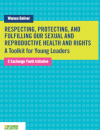 Respecting, protecting, and fulfilling our sexual and reproductive health and rights: A toolkit for young leaders
Respecting, protecting, and fulfilling our sexual and reproductive health and rights: A toolkit for young leadersThis toolkit provides information and guidance for young people to become expert leaders on advocacy for sexual and reproductive health and rights. It introduces key concepts and rights, explains how to investigate the status of SRHR in one's own community and country, and how to develop an advocacy strategy for change.
Women Deliver, 2015
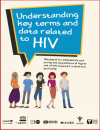 Understanding key terms and data related to HIV
Understanding key terms and data related to HIVA handbook to help young people aged 15-24 understand better the statistics around HIV issues. It is intended particularly for adolescent and young peer educators, young advocates and young people involved in HIV programming for young people from key populations. The handbook uses a comic-book format; the characters are teenagers who have conversations about understanding statistics, especially as they relate to data on HIV.
UNICEF, 2016
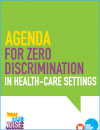 Agenda for zero discrimination in health-care settings
Agenda for zero discrimination in health-care settingsA brief outline of the UNAIDS action plan for eliminating discrimination in health-care settings, together with six measures of a zero-discrimination environment.
UNAIDS, 2016
 Straight to the Point: Advocacy tools
Straight to the Point: Advocacy toolsThese three concise tools explain and provide practical steps for setting advocacy priorities, assessing the political environment, and mapping an advocacy strategy. The tools are also available in French and Portuguese on Pathfinder International's website.
Setting advocacy priorities
Assessing the political environment for advocacy
Mapping an advocacy strategy
Pathfinder International, 2011
 ACT! 2015 - Advocacy strategy toolkit
ACT! 2015 - Advocacy strategy toolkitA practical toolkit for young people who want to advance HIV and sexual and reproductive health and rights through national advocacy in the post-2015 agenda. It offers a series of step-by-step modules to help young advocates (and their adult allies) build an effective strategy to influence decision-makers.
ACT! 2015 - Boite à outils de la strategie de plaidoyer
ACT! 2015 - Практическое пособие для разработки и реализации адвокативной стратегии
The PACT, 2014
 Youth advocates, act! A handbook on how to campaign for better sexuality education using the International Technical Guidance on Sexuality Education
Youth advocates, act! A handbook on how to campaign for better sexuality education using the International Technical Guidance on Sexuality EducationGuidance on how young advocates can use the 2018 International Technical Guidance on Sexuality Education to do effective advocacy in their own communities. The toolkit includes template letters to government representatives or schools, as well as conversation starters and a quiz on sexuality education topics.
Youth advocates, act! A handbook (ARABIC)
Jeunes defenseurs, agissez! Manuel
Promotores juveniles, actuen! Un manual
IPPF, 2018
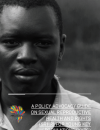 A policy advocacy guide on sexual reproductive health and rights (SRHR) for young key populations (YKPs)
A policy advocacy guide on sexual reproductive health and rights (SRHR) for young key populations (YKPs)A step-by-step guide to planning and implementing an advocacy campaign for policy changes regarding the sexual and reproductive health and rights of young people from key populations. The guide explains concepts, details the activities that are involved in advocacy, and lists additional resources.
AMSHeR, 2018
 "Hands off our clients!" An activism and advocacy guide for challenging the "Swedish Model" of criminalising the clients of sex workers in Europe
"Hands off our clients!" An activism and advocacy guide for challenging the "Swedish Model" of criminalising the clients of sex workers in EuropeThis toolkit contains information, ideas and resources to help sex-worker rights collectives, organizations and activists carry out advocacy and activism to influence or challenge policy or legislation on the "Swedish model" of criminalizing the clients of sex workers. Ten worksheets are included, as well as templates for activities.
ICRSE, 2016